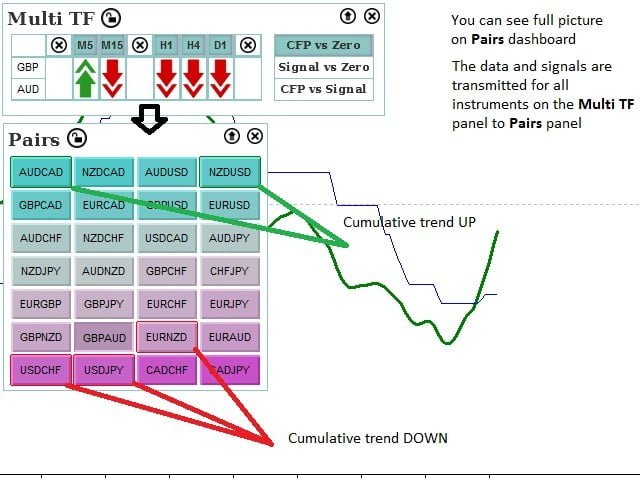This product is a cluster indicator that calculates the relative strength of the eight major currencies. For convenient analysis, obtaining a cross-section of the market, information panels were created, which also allow you to manage the indicator:
- Heatmap, Currencies-panels that display the relative strength of currencies.
- Pairs-a panel that visually shows currency pairs, and arranges them depending on the difference between the relative strengths of the respective currencies
- Speed-the panel shows the rate of change in the currency strength
- MuliTF is one of the main panels that should be used for analysis. This panel displays data from all periods.
The calculation of currency strength is based on cluster indicators:
- Complex Common Frames percent (CCFp)
- Complex Common (CC)
You can learn about the use of cluster indicators, for example, here.
Preparing the indicator for operation
For the indicator to work correctly, you need a history for all timeframes (except for the MN1 period) of the current instrument and the main instruments: EURUSD, GBPUSD, USDCHF, USDCAD, USDJPY, AUDUSD, NZDUSD. If you have received a notification about the need to load the history for the instrument, it is recommended to update the history for all timeframes at once and reload the indicator.
[spoiler title=”Read More…”]
Preparing the indicator for operation
For the indicator to work correctly, you need a history for all timeframes (except for the MN1 period) of the current instrument and the main instruments: EURUSD, GBPUSD, USDCHF, USDCAD, USDJPY, AUDUSD, NZDUSD. If you have received a notification about the need to load the history for the instrument, it is recommended to update the history for all timeframes at once and reload the indicator.
- Mode of calculation – the principle of calculating the indicator
- Complex Common Frames percent (CCFp)
- Complex Common (CC)
- The method of moving average-MA calculation methods for calculating indicator data
- Type of signal lines – the type of calculation of the signal line for CFP (the line showing the difference between the forces of currencies)
- Moving Average-Exponential moving Average. Recommended to use for MODE Complex Common
- Digital signal line-filters based on the analysis of the price of a currency pair are used in the calculation of the signal line. It is recommended to use for MODE Complex Common Frames percent
- Bars for analysis – the number of bars to analyze for all chart periods (which are included in the Multi TF panel). Do not set the value too high, as this can significantly slow down the application.
- Recalculation last bar-the parameter responsible for recalculating the indicator on the last bar. Enabling this option may slow down the application.
- Complex Common Frames percent (CCFp)
- Complex Common (CC)
- Moving Average-Exponential moving Average. Recommended to use for MODE Complex Common
- Digital signal line-filters based on the analysis of the price of a currency pair are used in the calculation of the signal line. It is recommended to use for MODE Complex Common Frames percent
SETTINGS FOR CCFp
- The fast period for analysis – the period for calculating the fast MA
- The slow period for analysis – the period for calculating the slow MA
- The period for Signal MA for CFP – the period for calculating the signal line
SETTINGS FOR CC
- Fast period for M1 – the period for calculating the fast MA for the M1 timeframe
- Slow period for M1 – the period for calculating the slow MA for the M1 timeframe
- The period for Signal MA for CFP for M1 – the period for calculating the signal line
- …….- MA period settings for each timeframe
SETTINGS FOR Momentum
- The period for calculating the momentum – the period for calculating the rate of change in the relative forces of currencies
SETTINGS FOR Open chart
Open new chart
Open new chart
With the help of the indicator panels, by clicking on the currency and currency pairs buttons, you can open the charts of other instruments (the Lock = Open icon).)
If Open new chart = true, the chart of the instrument will be opened in a new window.
If Open new chart = false, the chart will be reloaded to the current chart, which may take some time.
SETTINGS FOR Alerts Current Timframe
At the moment, signals and notifications can only be received from the current chart period.
This panel displays data on the CFP and Signal Line lines from the selected periods.
There are 3 buttons on the panel (signal selection):
- CFP vs Zero-the panel shows the positions of the CFP lines relative to 0.
- Signal vs Zero-the panel shows the positions of the signal lines relative to 0. It is recommended to use for MODE Complex Common Frames percentage and Digital signal Line
- CFP vs Signal-the panel shows the positions of the CFP relative to the signal lines.
Data and period settings from the panel are passed to the Pairs panel. If the signals match for all the selected periods, the currency pair is highlighted in green (uptrend) or red (downtrend).
[/spoiler]





